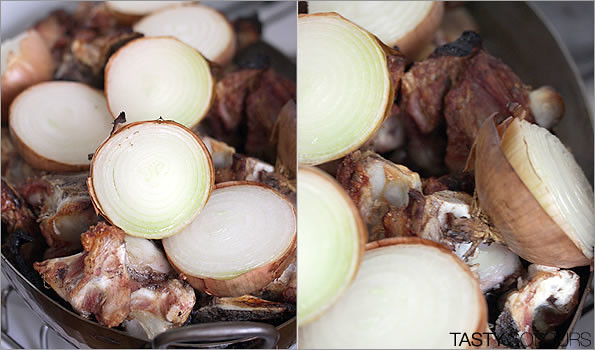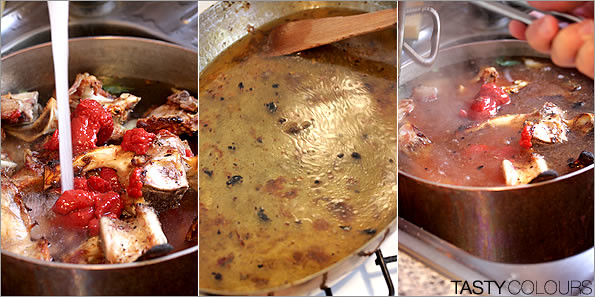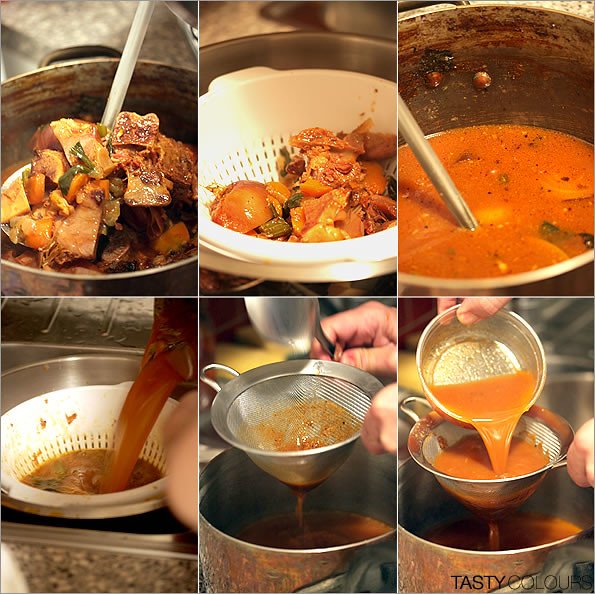In June, I presented the dish “Pierogi with Lamb”, for which I used my homemade veal stock reduced to demi - glace.
Stocks are the foundation of classic French Haute Cuisine. The French name for stock is fond - meaning “foundation”. There exist two types of stocks: white stocks and brown stocks. The first ones are prepared from bones of birds, fish or veal, which are simmered in water with vegetables and herbs. They are lighter than brown stock – the second type. To obtain a brown stock, one should fry or roast the bones first. Brown stocks may be made from veal, beef, poultry, lamb, pork, venison or even shells or shellfish.
This post is about brown veal stock. We make it at home several times per year. Some say that we are the last generation to learn how to cook with veal bones. It is not easy to buy them these days. Even in France, the legislation may change in the coming years, so we will not be able to buy them anymore. Still, we can buy them quite easily in butcher shops in Paris, and in Kraków.
As I already mentioned in my post about Pierogi with Lamb and Morels, veal stock is a kind of preparation that it is difficult to make at home (because, for example, in some countries you will not get any veal bones in any store – in this case one can use beef bones) and those industrial powdered stocks are hopeless. Moreover, to prepare homemade veal stock (or any other stock) is an absolute messy job. Furthermore, the authentic, homemade veal stock itself may not be very interesting in taste – its pure taste is not so pleasant. But what is fascinating about it is that once you combine it with other flavors, like for example, meat juices, wild mushrooms, butter, cream, garlic or alcohol - it becomes something absolutely outstanding.
There are tons of veal stock recipes. Some people like to dust the bones with flour before roasting them, others (like us) prefer not to roast the vegetables, or to deglaze the roasting pan with wine. Some prefer to add vegetables just one hour before the end of cooking. Others like to add bouqet garni. Just feel free to choose your favorite options. The recipe that I present here was given to me by my husband who taught me how to make good, classical veal stock and demi-glace. The recipe comes from one of the French restaurants, which he had been working et when he was younger.
Once your veal stock is ready, you can play with it further and reduce it to about one third and make a more concentrated stock called demi-glace , or reduce it even more (as little as a tenth of its original volume) – to obtain a glace – a sticky reduction ideal to flavor your sauces. I know: those sauces made with veal stock are not very light; but they are delicious; moreover, we do not eat them every day.
You will find here some advices to prepare a good veal stock, that I collected from my husband and from Michael Booth’s book (which helped me to write this post). Please note another book that I recently found: “Le Cordon Bleu’s Complete Cooking Techniques”.
I recommend cooking your own veal stock at least once in your life. If you cannot buy fresh veal bones, try to cook beef stock, following these instructions and the recipe:
(i) Use good bones (the fresher, the better), cut into small pieces;
(ii) Use fresh vegetables (“a stock made with garbage will taste like garbage” – Alice Walters – Chez Panisse) the so called “mirepoix” (combination of carrots, onions, celery and sometimes garlic and shallots);
(iii) The mirepoix should not dominate the flavor of the stock, so do not use too much of it (maximum around 20 per cent the weight of mirepoix to bones);
(iv) You can add a bouqet garni (a mixture of laurel leaves and thyme, sometimes parsley stems as well); we do not add any, as we want to have a clear, blend stock, which we will use later for various sauces of different flavors;
(v) We do not salt and pepper the stock, because it constitutes a base for sauces, which will be reduced and seasoned later; if you will salt the stock during simmering the risk is that you will waste your job because the salty taste will intensify after reduction;
(vi) It is important to simmer the stock for at least a few hours – a stock which will not be cooked enough, will be watery and without flavor; and on the contrary, a stock which will be overcooked may become bitter;
(vii) Do not use a nonstick frying pan or saucepan to roast the bones – you need a good “sticky” roasting-pan, so you can deglaze all goods that stuck to its surface while roasting the bones.
Ingredients:
3 to 4 kg good quality and fresh veal bones, cut into pieces by your butcher, rinsed under cold water and dried (you can replace veal bones by beef bones, but beef stock is not as good as veal stock, because veal bones have more gelatin so the sauce will look better)
4 big onions, washed from soil, dried (but not peeled!), cut into halves
2 small cans of tomato paste
2 to 3 stalks of celery, washed and chopped in thick slices
3 carrots, washed and cut into thick slices
1 large, thick-bottomed roasting pan
1 large saucepan of about 10 liter capacity (the best is a narrow and high saucepan to minimize evaporating during cooking)
1large strainer
1”chinois” or muslin
Heat the oven to 220° Celsius (430° Fahrenheit). Place the bones in the roasting pan and place the pan in the oven for about 1.15 to 1.5 hours. Be careful – the bones should brown evenly, and not burn. For that purpose, occasionally remove the roasting pan from the oven and flip the bones.
Once the bones are slightly gold (after about one hour), place onions on top of the bones. Roast everything another 15 to 20 minutes (you should really watch the onions and bones to prevent them from burning).
In the meantime, add slices of celery and carrot into the saucepan.
Then remove the roasting pan from the oven. Add onions and bones to the saucepan. Add tomato paste.
One important thing: the bones render some fat while roasting. Drain off as much of the fat as possible, using a sieve to catch the precious brown bits from the bottom of the pan. Do not throw away those brown bits! Pour some water into the roasting pan and deglaze it over heat by scraping all browning from the pan. Pour the liquid into the saucepan with bones and vegetables.
Fill the saucepan with cold water (about 5 cm above the level of the bones) and bring to a boil. Then reduce the heat to an absolute minimum, so it can simmer. It should simmer gently between 5 and 6 hours. Simmering does not stir up impurities in the way that a rolling boil would and keeps the stock clearer. The bones have to have enough time to give their full flavor. Occasionally, using a ladle, remove the impurities (mostly fat) which will rise to the top.
Using a ladle, strain the stock through a strainer set over a large bowl. Discard bones, vegetables and all other big solids. Then, using a “chinois” or a muslin, strain the stock once more, in order to get rid of smaller solids. Your stock is ready to use. It should have the brownish-cold color, similar to something between milk chocolate and caramel. At this stage, you can pour portions of the stock into plastic containers and freeze it, should you wish to use it later.
If you want to make demi-glace, apply the following instructions: pour the stock into a smaller saucepan and bring it to a boil. Once it is boiling, reduce the heat to a minimum. Simmer for about one hour - the cooking time will however depend on the thickness of the stock - sometimes you will need a bit less, sometimes more time. The best test to do is to pour a bit of stock into a cup and place it in the fridge. Once it thickens when cooled down, the stock is ready. Occasionally, with a ladle, remove the foam which will form on the top.
Pour the veal stock into small plastic containers or ice cubes moulds. Once it is cooled down, freeze it and use it when needed.















15 comments:
Oh yeah... Fond brun and other stocks, all of which make the French cuisine so outstanding. Yes, in my opinion it is the absolute perfection of French chefs in preparing potages, fonds and sauces that define what haute cuisine is. Other things too, but without the wide variety of sauces based on meat stocks cuisine de France would be yet another among many other European cuisines.
This particular brown stock is a good example of Maillard reaction and its results. The stock owes its color and flavor to that chemical reaction between reducing sugars and aminoacids contained within meat and bone marrow. This is how Europeans used to add sweetness to their food before they possessed the secret of sugar.
I prefer to toss in additional flavors when making my basic brown stock (and other stocks as well). That's why I will sligthly brown my veg, add bouquet garni of parsley, rosemary, thyme and sage and deglaze the roasting pan with a glassfull of good white. Just love the aroma permeating the kitchen after 6 hours of slow simmering.
From there there's a whole world of possibilities which I yet have to try out myself. Gravies are so much better when made with such brown stock and dark roux, instead of just thickening meat juices with flour. A proper onion soup should only be made with prime veal or beef brown stock. When I have more (and I mean much more) spare time I will definitely want to try some ancient recipes by Careme, using Spanish sauces, I mean sauces espagnoles.
Now, let's check out that pizza dough I left to rise some 2 hours ago...
Cudowny post. Mam nadzieję, że uda Ci się rozpropagować ideę przyrządzania bulionów w domu. Jestem zadeklarowaną przeciwniczką wszelkich kostek rosołowych i zawsze muszę mieć zapas domowego w zamrażalniku. Jak plecy? Lepiej?
I've never made veal stock, only beef, but always wanted to give it a try. I suspect I can find excellent quality veal bones here in Los Angeles, but I don't have a big oven to brown the bones, and don't have a big pan either.... it seems that I am again out of luck!
Magdalena, this is some post - you are so nice to share allof the details! I have never made veal stock or demi-glace, but I would love to give this a try! Thank you for sharing.
Best regards,
Gloria
Magda, jesteś moją idolką - nie tylko szkolę sobie u Ciebie angielski to jeszcze własny warsztat kulinarny. Buliony wprawdzie najróżniejsze robię i nie wyobrażam sobie bez nich życia, ale tak jasna relacja o tym jak się je przyrządza przyda się zawsze :) Przyznam, że cielęcego bulionu jeszcze nie robiłam, choć wołowy dokładnie na tej samej zasadzie już kilka razy. Najczęstszy jednak to bulion warzywny lub z kurczaka - czasem jasny, czasem ciemny z przypieczonego korpusu :)
I remember when you sent me this recipe ages ago and how pertified I was to make my own stock. Due to the lack of veal bones in my area I have made a beef stock inspired by your recipe and I absolutely love it. I have posted it on my blog, as I was so proud of it. ;) It makes huge difference to soups and sauces. Thanks again, Magda! :)
Everything looks perfect and tasty on your blog! So, you recommend the LCB's book? I'm looking for a new cookbook that can enhance the cooking skill.
I totally agree, a good veal stock or demi-glace is the best foundation for a great meal; it is so handy to have available in the freezer for sauce and steaks and stews etc, your step-by-step photos are so helpful.
I used to work in a fine dining kitchen where we made veal stock a couple of times a week but this reminds me I should do it at home, especially now it's getting coder! Great work.
Ohh i love veal stock. And your pictures are just fabulous. I am going to save this recipe for next time and follow your steps instaed of mine. I hope all is well.
Jak znow bede robic wywar, to mam nadzieje sie zastosowac do wszelkich wytycznych Magda :)
Kilka godzin gotowania, do tego to jednak mi trzeba bedzie dlugo dorastac...
Sle pozdrowienia!
Thanks for all your comments. I feel embarrassed for not answering, I hope I will find enough time tomorrow...anyway, I read all of them :)
In Polish:
Dzieki Wam wszystkim za komentarze. Przepraszam, ze odpisuje dopiero dzis. Choc czytam je regularnie, nie mialam czasu...
Lo, dzieki plecy lepiej. Ja tez nie uznaję kostek rosołowych, choć w czasach studenckich często z nich korzystałam. Teraz zawsze robię domowe i mrożę, nawet zwykłe rosoły.
Tilianaro, miło słyszeć i przepraszam, że dopiero teraz odpowiadam. W ferworze obwiązków zupełnie nie miałam weny na pozrądne odpisywanie na posty...i tak się dużo tego zebrało, że teraz mnie ten fakt lekko przeraża. Wołowy też jest ok, niektórzy twierdzą, że jest nawet bardziej smaczny . O, a z korpusu kaczki również pyszny jest (niestety o korpusie kaczki moge sobie pomarzyć tu).
Basiu, I co udalo sie ???
Guys, thanks a lot for your comments. I am answering only today but believe that I was awfully busy. Anyway remember that I always read all comments !
Dear Kucharz, indeed there are chefs who like to brown vegetables, add bouqet garni and so on. This is a matter of individual taste and I am going one day to experiment more with various version of veal stocks.
Sally, beef stock is ok, too. Is there any chance to have a regular, big oven soon ?
Thanks, Gloria. Hope you’ll try it one day.
Karolina, I know, I know….next time I will prepare beef stock !
Tanatha, thanks a lot! After reading the whole book, I can tell you that I found what I need (meaning, boning the meat and fish and so on). But there are some chapters that conained too basic information, not suffficient for me.
Joumana, Sasa, Delish - thanks a lot guys, it nice nice to hear that you love stock, too !
Jeszcze nie Magda, ale mnie zazwyczaj dlugo zabiera nim jakis przepis wyprobuje - wszystko przez ten perfekcjonizm :-)
Pozdrawiam!
Post a Comment